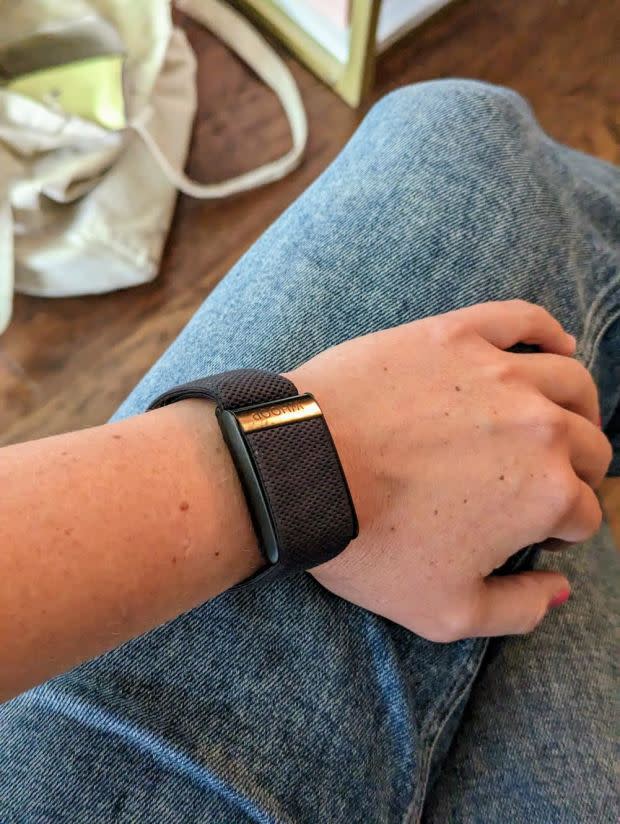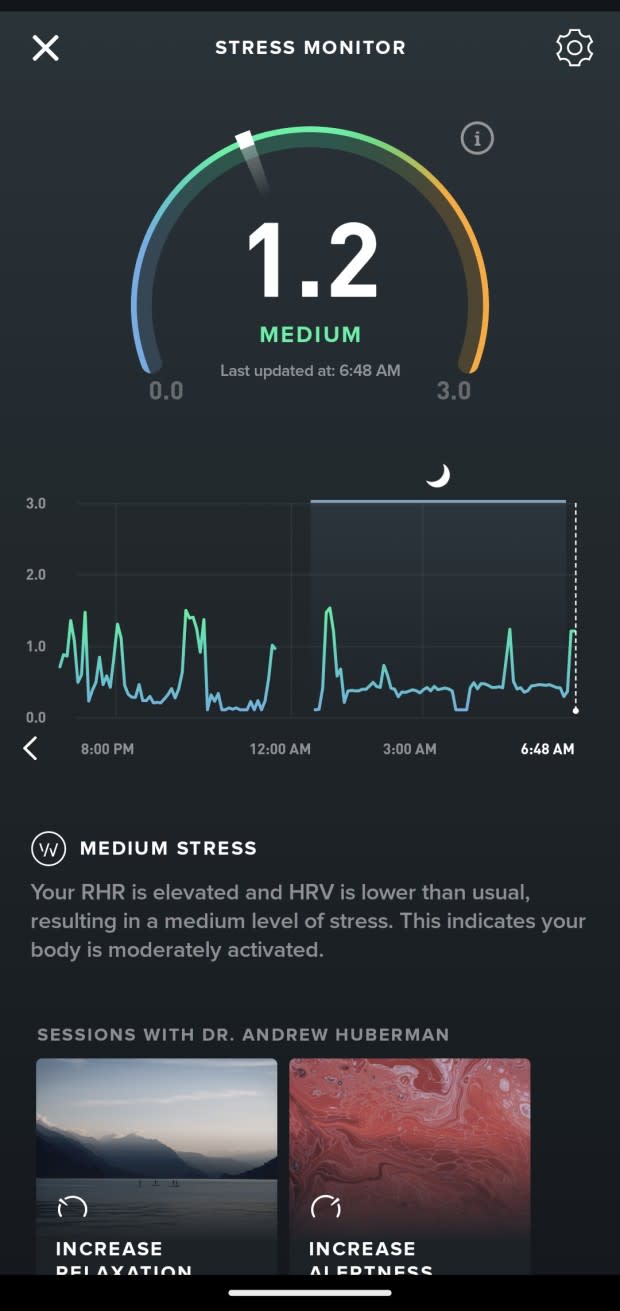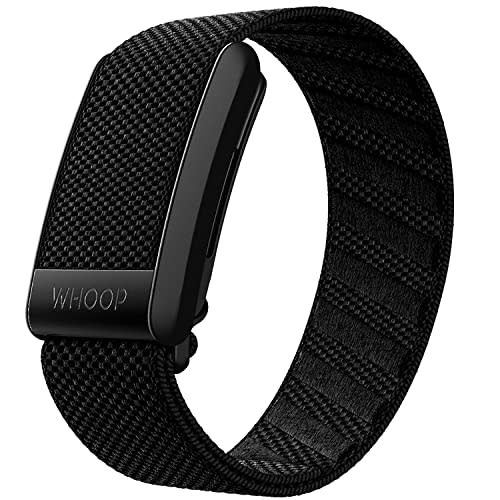'I Wore a Wearable Stress Tracker for 2 Weeks Straight and Was Shocked by the Time of Day I'm the Most Stressed'
Remember when it was revolutionary to know how many steps we took per day? That’s child’s play compared to what wearables can tell us today. Now, activity trackers and watches can tell us how much REM sleep we’re getting, keep up with our menstrual cycles, and serve as a personal fitness coaches.
Whoop has differentiated itself from the other trackers out there by focusing on rest and recovery. The latest model, Whoop 4.0 ($239), tracks heart rate so it can sense when you’re working out, how well-rested you are, and how well you recover from physical strain. In March, the company unveiled its latest feature: a stress monitor that allows users to track their stress levels in real-time. Curious to learn more about how it works and if it’s actually helpful to track stress, I decided to give it a try.
Here at Parade.com, we're all about sharing products we love with our audience. When you make a purchase on an item seen on this page, we may earn a commission, however, all picks are independently chosen unless otherwise mentioned.
WHOOP 4.0 with 12 Month Subscription – Wearable Health, Fitness & Activity Tracker – Continuous Monitoring, Performance Optimization, Heart Rate Tracking – Improve Sleep, Strain, Recovery, Wellness
Related: These Are the Best Fitness Trackers of 2023
How Whoop’s Stress Tracker Feature Works
When I first learned about Whoop’s stress tracker, I was skeptical that the wearable could actually tell the difference between physical stress (AKA an intense workout) and mental stress. Heck, sometimes I don’t even realize when I’m mentally stressed. To learn exactly how it works, I set up a Zoom call with Kristen Holmes, Whoop’s Vice President of Performance Science.
Holmes explained to me that Whoop measures a person’s heart rate and heart rate variability (HRV), which is when the amount of time between heartbeats fluctuates slightly. Most of the time, people don’t notice when these fluctuations happen, which is why having a wearable that tracks them comes in handy. A change can indicate when someone is feeling anxious or stressed because it shows a change in heart rate that isn’t caused by physical stress. Holmes explains that the Whoop can also detect motion, so if someone’s heart rate increases without accelerated motion, this is a sign that someone may be experiencing mental stress.
Taking this into account, the stress monitor will give you a score between 0 and 3 to indicate how mentally stressed you are. Holmes says that the purpose of tracking stress levels is so people can see an actual chart showing when they’re stressed, which can clue them in as to why they’re stressed and then take action to lower it. “If you don’t understand why you’re stressed, how do you even begin to manage it? This is an awesome opportunity to learn more about your body on a deeper level.”
With that in mind, I decided to give it a try.
Related: 12 Pieces of Health Tracker Jewelry to Help You Hit Your Health Goals
How Whoop’s Stress Tracker Feature Worked for Me
I didn’t have a Whoop, so the company was generous enough to send me one to try. Since I’d never used it before, figuring out how to use the Whoop, in general, came with a learning curve that I found trickier than figuring out activity trackers I tried in the past, like my Fitbit or Google Pixel Watch.
The Whoop requires charging a battery pack and then the Whoop itself, which confused me a little. I often felt like there was always something that needed charging, which cut down on how much I could actually wear the Whoop. But mastering this is likely human error on my part; Whoop’s website says that it stays charged for four to five days.
The other hurdle for me was actually wanting to wear it all the time. This is not an issue I’ve had isolated to Whoop; I find myself taking off any wearable I’ve owned, mostly whenever I don’t think it matches my outfit. (Is it just me or does seeing someone in a dress with an activity tracker slapped on their wrist remind them of Spy Kids?) At the very beginning of my three-week experiment, I wasn’t consistently wearing my Whoop because I kept taking it off to charge or whenever I didn’t like how it looked with my outfit. This impacted the stress monitor because it affected how much data the Whoop was able to collect. Instead of a score, it simply said “No data.” Lesson one: Consistency is key. If you really want to know your stress score, you have to commit to keeping the Whoop on, which I vowed to do for the remaining two weeks of my experiment.

Emily Laurence
Once I committed to wearing the Whoop 24/7, I was able to see how my stress rose and fell throughout the day (and night). I was able to get some data after 24 hours, and my stress levels became crystal clear after wearing it 24/7 for multiple days in a row. What I liked about the stress monitor is that I wasn’t bombarded with alerts; it was simply working in the background. Instead of getting push notifications such as “You feel stressed! Stop being stressed!”, I could simply pull up the stress monitor section of the app on my phone whenever I wanted to check it out.
In general, I don’t lead a very stressful life. My job is manageable and I don’t have kids. So I was not surprised to see that my stress score was low. The chart did show that I experienced more mental stress in the middle and late afternoon than in other parts of the day. This was interesting to me. It made me think about how I structured my day and what could be causing that stress.
After thinking about it, I was able to realize that it could be because the workday was winding down but I wasn’t as far down my to-do list as I wanted to be. Thinking about the work I wouldn’t be able to finish was a bit stressful. I made a mental note to myself to start ending the workday with either a walk or an evening jog because walking or jogging outside always makes me feel less stressed.
One sunny Saturday afternoon, I took a trip to a local plant store and bought four big, potted plants for my apartment balcony. It took me several trips to lug everything from my car up the three flights of stairs to my apartment. Later, when I checked out my Whoop, I saw that it had logged my stress score as "medium." But this wasn't accurate. I wasn't stressed at all during this time; in fact, I was very content shopping for and setting up my new plants. My hunch is that the Whoop detected my heart rate going up (the pots were heavy and I was carrying them up three flights of stairs), but didn't detect me doing an exercise, so it assumed I was stressed out.

Emily Laurence
People who get a high-stress score and actually are stressed but aren’t sure how to manage it can use Whoop’s guided breathing sessions, led by Dr. Andrew Huberman, Ph.D., a neuroscientist and associate professor in the Department of Neurobiology and Psychiatry and Behavioral Sciences at Stanford University School of Medicine. Through the app, Dr. Huberman guides users through cycling sighing, which is taking two quick inhales followed by a long exhale. Doing this increases relaxation and changes the state of the autonomic nervous system.
While I did find Whoop’s new stress monitor feature interesting, what I liked most about my Whoop experiment was getting insight into my sleep cycle. It tracks all four stages of the sleep cycle, including REM sleep. This interested me because getting enough REM sleep is important for brain health, including lowering the risk of dementia. I got super into seeing how much REM sleep I was getting a night. Did having alcohol before bed impact it? (It did—for the worse.) Did sleeping at my boyfriend’s place impact it? (It did not—phew!).
Whoop's new stress feature didn't always seem accurate to me, but I'm hopeful this type of technology will get better over time because I strongly believe knowledge is power. Looking at a chart and seeing when you’re stressed can serve as the first step toward addressing the problem. The same goes for sleep. “We have a lot of control over our mental, emotional and physical states,” Holmes told me during our Zoom call. “You can change the data if it’s not where you want it to be—and that’s pretty empowering.”
Next up, check out these 19 workout apps that can help you reach out fitness goals.


